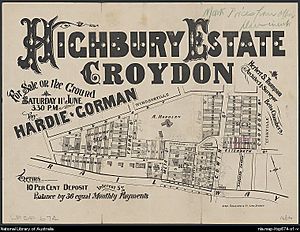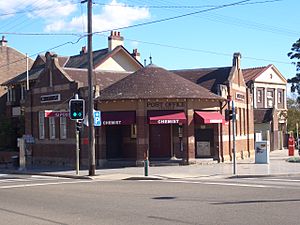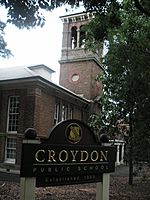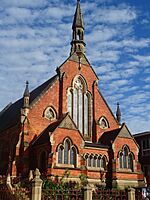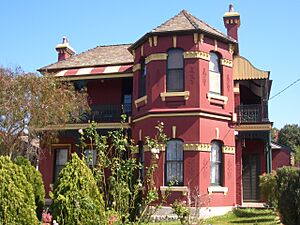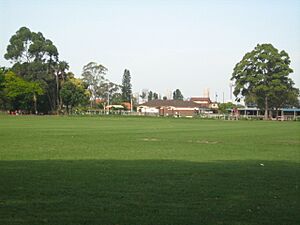Croydon, New South Wales facts for kids
Quick facts for kids CroydonSydney, New South Wales |
|||||||||||||||
|---|---|---|---|---|---|---|---|---|---|---|---|---|---|---|---|

The Strand, Croydon
|
|||||||||||||||
| Postcode(s) | 2132 | ||||||||||||||
| Elevation | 23 m (75 ft) | ||||||||||||||
| Area | 2.4 km2 (0.9 sq mi) | ||||||||||||||
| Location | 9 km (6 mi) west of Sydney CBD | ||||||||||||||
| LGA(s) |
|
||||||||||||||
| State electorate(s) | Strathfield | ||||||||||||||
| Federal Division(s) | |||||||||||||||
|
|||||||||||||||
Croydon is a suburb in the Inner West area of Sydney, New South Wales, Australia. It is about 9 kilometres (5.6 miles) west of the main city centre of Sydney. Croydon is special because it's split between two local councils: the Municipality of Burwood and the Inner West Council.
This suburb is located between the busy areas of Ashfield and Burwood. It has Parramatta Road to the north and Iron Cove Creek to the east. The suburb's name comes from Croydon, a large town in the south of London, United Kingdom.
The original people of this land were the Wangal people. They are part of the larger Eora nation.
History of Croydon
First People of the Land
Before Europeans arrived, the land where Croydon is now was home to the Wangal people. They were part of the Eora nation. Their main area was around Concord. It stretched east towards Long Cove Creek.
The land was full of tall trees like eucalypts. There were also mangroves in the lower, swampy areas. The Wangal people mostly ate fish. So, they lived close to the Parramatta River. They fished from their canoes.
Away from the river, they found fruits and plants to eat. They also hunted animals like possums and kangaroos. These animals were used for food and their skins.
When the First Fleet arrived in 1788, things changed. One of the Wangal leaders, Bennelong, became friends with Governor Arthur Phillip. Bennelong even travelled to England.
A rough path was made between the first two settlements. This path went through the lands of different Aboriginal groups. This track later became a main road for Sydney. It also shaped how Croydon grew.
Early European Settlement
The first land grant in Croydon was given in 1793. Captain John Townson received 100 acres. Other grants followed in 1794. Augustus Alt, the first surveyor, built a home called 'Hermitage Farm'.
However, his house was burned down in 1797. He then moved to nearby Ashfield. He sold his land to John Palmer.
By 1820, a big part of the area was owned by Joseph Underwood. His 'Ashfield Park Estate' stayed mostly whole for over 40 years. After 1858, the land was divided into smaller blocks. This happened because the railway made the area popular.
One part was called the 'Highbury Estate'. Here, Anthony Hordern built his house, 'Shubra Hall'. He was the son of a famous shop owner. This house is now part of the Presbyterian Ladies' College, Sydney. The College and Shubra Hall are now protected as heritage sites.
From 1800 to 1860, Croydon grew slowly. Forests were cleared for farms and grazing animals. The area was known for bushrangers in the 1820s. These were outlaws who robbed people on the main roads.
In 1855, the railway line from Sydney to Parramatta was built. This caused many new houses to be built near the stations. In 1874, a new station was built. It was first called Five Dock. But this caused confusion, so it was renamed Croydon in 1876. It was named after the suburb in London.
How Croydon Grew
The first new buildings were near the station. Anthony Hordern built his large home, 'Shubra Hall', in 1869. Many shops on Edwin Street North were built in the 1880s. Many houses from this time are in the Victorian style.
The first schools opened in the 1880s and 90s. Croydon Public School opened in 1884. The Presbyterian Ladies' College moved here in 1891.
The southern part of Croydon developed later. The Malvern Hill Estate was divided in 1909. It was planned to be a model suburb. It had wide, tree-lined streets. Houses were built in the Federation style. The Strand shopping street was part of this plan. It still looks much the same today.
Since World War I, Croydon has not changed much. Some apartment buildings were built. But many are art deco style from the 1930s. They fit well with the older buildings.
Heritage Places
Croydon has several places that are protected for their history. These include:
- Croydon railway station on the Great Southern and Western railway line.
- Shubra Hall on Boundary Street.
- The Croydon Sewer Vent on Paisley Road.
Things to See and Do
Shops and Businesses
Croydon's main shops are near the railway station. The Strand is the main shopping street. It has many shops with homes above them. You can find grocery stores, restaurants, and bakeries there.
The older Edwin Street area has special businesses. These include accounting firms and printing shops. Some shops on Parramatta Road are also in Croydon.
Schools in Croydon
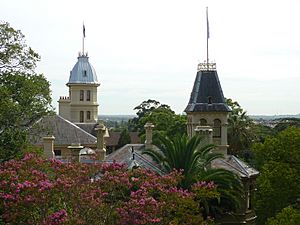
Croydon has four schools. Two are primary schools and two are secondary schools. The oldest school is Croydon Public School. It's a public primary school for both boys and girls. It opened in 1883. Over 700 students go there.
Holy Innocents Catholic Primary School is another primary school. It's a Catholic school for boys and girls. It opened in 1924. About 200 students attend this school.
Burwood Girls High School is a secondary school for girls. It is actually in Croydon, even though its name says Burwood. About 1200 girls go to this public school. It started in 1929.
Presbyterian Ladies' College, Sydney (PLC Sydney) is another school for girls. It's a private school for all ages, from kindergarten to Year 12. It's a day school and also has boarding for students who live there. It opened in 1888. It moved to Croydon in 1891. About 1150 girls attend PLC Sydney. Many students at both girls' schools travel from other suburbs.
Getting Around Croydon
Croydon railway station is on the Sydney Trains network. Trains run every fifteen minutes. You can go east to the city or west to Homebush or Parramatta.
Seven bus routes pass through Croydon. They connect Croydon to places like Burwood, the city, and Kingsford. Some buses also go to Drummoyne and Hurstville.
Croydon is between two big roads: Parramatta Road and Liverpool Road. There is only one road bridge over the railway line in Croydon. This bridge connects the north and south parts of the suburb.
Until 1948, electric trams also served Croydon. These trams were later replaced by buses.
Important Buildings
Churches
Croydon has several churches:
- All Saints of Russia is a Russian Orthodox Church.
- Holy Innocents Catholic Church.
- Malvern Hill Uniting Church.
- St Christophorous is a German-speaking Catholic Church.
- St Gabriel Syrian Orthodox Church.
- St Joseph's Maronite Catholic Church.
- St James' Anglican Church Croydon.
- Sydney Missionary and Bible College.
Homes in Croydon
Croydon is known for its beautiful, large homes. Many houses were built in the early 1900s. They are often in the Federation Bungalow or California Bungalow styles. Most homes in Croydon are separate houses.
The Malvern Hill area was planned in 1906. It was designed to have modern houses on big blocks of land. It also has wide streets. Homes here are very popular and can be quite expensive.
Parks and Green Spaces
Centenary Park is a large park. It has a barbecue area, bike tracks, and play equipment. There's also a basketball court and cricket nets. It has two fields for sports like cricket, rugby, and football. The Bede Spillane Dog Park is next to it.
Blair Park is another sports park. It has a sports field, a playground, and an off-leash area for dogs.
Wangal Park is being redeveloped. It used to be a brickpit. It will have three wetlands and boardwalks. The first part opened in 2015.
Croydon also has smaller parks. These include Reed Reserve, Froggatt Crescent Reserve, and Bridges Reserve.
Street Art
Near the Adelaide Perry Art Gallery, you can see some street art. On the back of two billboards, the name "BLADEE" is spray-painted. This might be a nod to the Swedish musician Bladee.
People of Croydon
Who Lives Here
In 2021, Croydon had 10,755 people living there. Most homes are separate houses (55.1%). About 27.0% are apartments. The rest are terraces or townhouses. People in Croydon are a bit older than the average in Sydney. More people own their homes outright here.
Croydon has many people born overseas. This is common in Sydney's Inner West. About 31.3% of people were born in Australia. Many others were born in China (16.5%), Italy (6.4%), and Lebanon (4.3%).
The most common backgrounds are Chinese (23.2%), Australian (17.5%), and English (17.3%). About half of the people (51.1%) speak only English at home. Other languages spoken include Mandarin (11.9%), Cantonese (6.0%), and Italian (4.7%).
Famous People from Croydon
Many interesting people have lived in Croydon. Here are a few:
- Joseph Abbott (1843–1903) – a wool-broker and politician.
- Augustus Alt (1731–1815) – the first surveyor-general of New South Wales.
- Bert Appleroth (1886–1952) – he started the company that makes Aeroplane Jelly.
- Francis Birtles (1881–1941) – an explorer and writer.
- Eleanor Dark (1901–1985) – a very important Australian novelist.
- Freda Du Faur (1882–1935) – a famous mountaineer.
- Walter Wilson Froggatt (1858–1937) – an expert on insects and a writer.
- Anthony Hordern (1819–1876) – a big name in shopping, he built Shubra Hall.
- Arthur Murch – an artist who won the Archibald Prize.
- Sir Bertram Stevens (1889–1973) – he was the Premier of New South Wales from 1932 to 1939.


